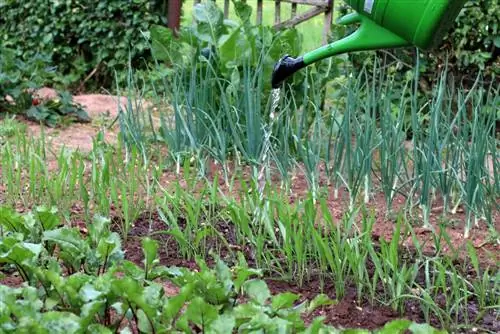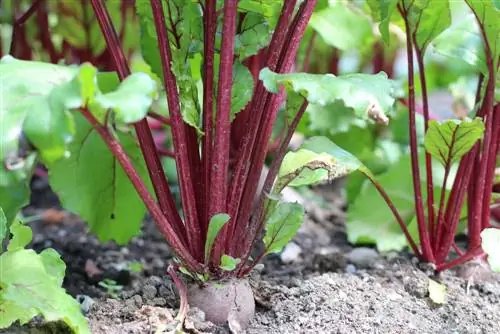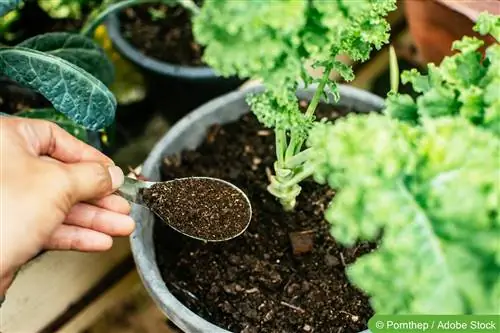- Author admin [email protected].
- Public 2023-12-24 17:10.
- Last modified 2025-06-01 06:48.
The division according to the depleting properties of a plant, i.e. according to its nutrient consumption, does not refer to all the nutrients that are present in the soil, but primarily to nitrogen consumption. Those plants that have a low need for nitrogen are called low feeders because they only remove a small amount of nitrogen from the garden soil. Plants that consume medium amounts are called medium feeders. Plants - especially vegetables - with a very high nitrogen requirement are the so-called heavy feeders.
What needs to be taken into account for heavy eaters?
When growing vegetables, it can easily happen that the soil becomes very depleted after a short time. Especially if the same vegetables are always grown on a bed and if they are species that have a very high nutrient requirement. This phenomenon is also called soil fatigue and leads to
- yields fall even though the plants are he althy
- the development of the plants is very limited (poor)
- a nutrient deficiency occurs
- pests and diseases can spread

For this reason, it is important to say goodbye to monoculture and haphazard cultivation in your own garden and to plant vegetables according to crop rotation and mixed culture. In order to create a sensible plan for a vegetable patch, you should know which plants have a very high nitrogen requirement, i.e. are heavy feeders.
Nitrogen as a nutrient in the garden
Nitrogen is often referred to as the “engine of growth”. Nitrogen is the nutrient that has the greatest influence on plant growth. Of course, the prerequisite is that the other necessary nutrients are also available in sufficient quantities. Nitrogen is involved in building plant structure (in proteins) and chlorophyll. This is why plants that are well supplied with nitrogen appear greener. They also grow faster and develop more leaves and branches than poorly cared for plants. Heavy feeders in flowerbeds or vegetable gardens in particular require relatively high amounts of nitrogen, which is why the soil usually needs to be fertilized or prepared.
Strong vegetables
Heavily consuming vegetables can be divided into different groups. Some plant families have a lot of heavy feeders. The transition between heavy and medium feeders is fluid, which is why in some lists plants that are in the transition zone are counted as heavy feeders and in others as medium feeders. Plants that prefer high nutrient levels in the soil include:
Cruciferous family - Brassiacaceae
The genus cabbage (Brassica) is located among the cruciferous plants. Many important cultivated plants in the garden (and in the field) belong to this genus. Almost all types of cabbage are heavy feeders, with the exception of kale, turnips and kohlrabi, which are medium feeders.
- Cauliflower (Brassica oleracea var. botrytis)
- Broccoli (Brassica oleracea var. italica)
- Chinese cabbage (Brassica rapa subsp. pekinensis)
- Romanesco (Brassica oleracea var. botrytis)
- Red cabbage (Brassica oleracea convar. capitata)
- Brussels sprouts (Brassica oleracea var. gemmifera)
- Pointed cabbage (Brassica oleracea var. capitata f. alba)
- White cabbage (Brassica oleracea convar. capitata var. alba)
- Savoy cabbage (Brassica oleracea convar. capitata var. sabauda)
In addition to the different types of cabbage, there are other cruciferous vegetables:
- Turnips such as autumn and May turnips (Brassica rapa var.)
- Radish and radishes (Raphanus sativus var.)
- Arugula (Eruca vesicaria)
Nightshade family - Solanaceae
Some well-known nightshade plants also require high nutrient contents:
- Eggplant (Solanum melongena)
- Potato (Solanum tuberosum)
- Paprika, pepperoni and chili (capsicum)
- Tobacco (Nicotiana)
- Tomato (Solanum lycopersicum)
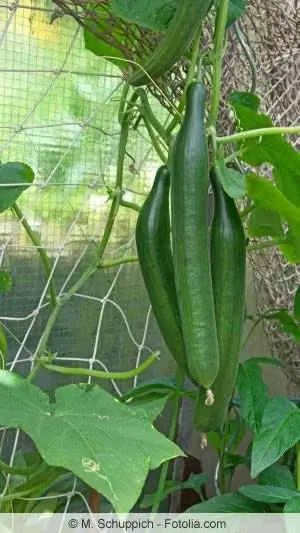
Pumpkin family - Curcubitaceae
With the pumpkin family it is easy to understand that the plants need high nutrient levels in the soil. After all, the plants have to put enormous energy into building their large fruits within a very short period of time.
- Cucumis (Cucumis sativus)
- Pumpkin (Cucurbita var.)
- Melons such as muskmelons (Cucumis melo) and watermelons (Citrullus lanatus)
- Zucchini (Cucurbita pepo subsp. pepo convar. giromontiina)
Beets - Beta
Beets belong to the foxtail family. The beetroot is not only related to the sugar beet, but also to the chard, which some gardeners may not be aware of at first glance.
- Chard (Beta vulgaris subsp. vulgaris)
- Beetroot (Beta vulgaris subsp. vulgaris)
- Sugar beet (Beta vulgaris subsp. vulgaris)
Other heavy-feeding vegetables
- Artichoke (Cynara cardunculus) - daisy family (Asteraceae)
- True spinach (Spinacia oleracea) - Foxtail family (Amaranthaceae)
- Leek (Allium ampeloprasum) - Allium family (Allioideae)
- Carrots (Daucus) - Umbelliferous plants (Apiaceae)
- New Zealand spinach (Tetragonia tetragonioides) - ice plant (Aizoaceae)
- Rhubarb (Rheum rhabarbarum) - Knotweed family (Polygonaceae)
- Celery (Apium) - Umbelliferae (Aspiaceae)
- Asparagus (Asparagus officinalis) - Asparagus family (Asparagaceae)
- Sunflower (Helianthus annuus) - daisy family (Asteraceae)
- Sweet corn (Zea mays) - sweet grasses (Poaceae)
Local loy alty heavy eaters
The highly consuming plants in the vegetable garden also include:
- Strawberries
- Rhubarb
- Asparagus
- Fruit trees
- Flowers: chrysanthemums, geraniums
These plants are grown perennial in most gardens and can be kept on the same bed for several years. In order for them to find appropriate nutrient levels in the soil, they must be provided with sufficient compost, manure (vegetable) or horn meal. Strawberries usually change location every three years.
Soil preparation
If mainly heavy feeders are to be grown in the vegetable patch, green manure, compost or stable manure should be applied in the previous year. In the spring, another portion of ripe compost is added. This should be very finely crumbly (it is best to sift it beforehand). The following fertilizers are used for heavy feeders:
-
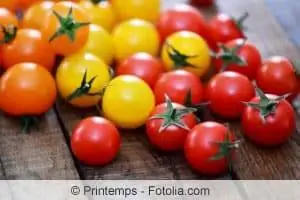
tomatoes Autumn (previous year): cow manure, horse manure, chicken manure (pre-composted), 2 shovels per m²
- alternatively compost (aged 1-2 years) plus horn meal or horn shavings (contain 14% nitrogen)
- fine, three-year-old compost in spring
But be careful, some plants that are known to be heavy feeders cannot tolerate fresh manure on the bed. This includes carrots (they become “leggy”), celery and leeks also suffer. In this case, it is better to grow them on a weak herb bed. This problem does not arise with composted manure or compost (which has been stored for about a year).
Tip:
Some gardeners also swear by fertilizing with nettle manure several times during the growing season.
Stable manure or compost?
A common misconception is the belief that compost can be used as an alternative to manure. The two fertilizers must not be completely equated because
- Compost is a pure humus fertilizer
- just improving the soil
- there is no comparable nitrogen supplier to stable manure
Tip:
Be careful with fresh manure! Some species contain ingredients that “burn” the plants. Therefore only use seasoned stable manure or work it into the soil in autumn so that these unwanted ingredients can break down.
When and how much to fertilize?
Organic fertilizers such as manure or compost must first release the nitrogen they contain. They should be worked into the ground in autumn. And: not all stable manure is the same. Because horse manure actually only consists of contaminated straw, it contains much less nitrogen than farm cow or pig manure. Mineral fertilizers are usually water-soluble. The nutrients are released very quickly and are immediately available. A small portion of these fertilizers should be applied several times at the beginning of the growing season so that the plants are not oversupplied and the groundwater is unnecessarily polluted.
- Stable manure: about 2-3 kg horse manure or 1 kg pig manure per square meter
- Compost: 1-3 kg per square meter, autumn or spring
- Horn shavings or horn meal: according to instructions
- Mineral fertilizer: according to instructions (maximum 10-15 g per square meter)

Also pay attention to crop rotation
The types of vegetables must also be sorted according to the plant family for the next crop! Plants from the same family should only be planted again on the same bed after three years at the earliest (better after four to six). These include:
- Umbelliferous vegetables: fennel, dill, celery, carrots, celery, parsnip
- Iceweed family: New Zealand spinach
- Grasses: corn, rye
- Astrological family: artichoke, chicory, endive, almost all types of lettuce
- Cruciferous vegetables: radishes, radishes, cabbage, mustard, horseradish, kohlrabi
- Pumpkin family: pumpkin, cucumber, melon, zucchini
- Lily family: leek, chives, garlic, onion
- Nightshade family: tomato, pepper, eggplant, potato
- Butterflies: peas, beans
Tip:
Heavy feeders can usually also be combined with medium-feeding plants. A combination with weak eaters should be avoided!
Conclusion
In addition to some fruit trees, the heavy feeders include many types of cabbage. Vegetable plants that produce very large fruits in a very short period of time also generally require a lot of nutrients. This group includes cucumbers, pumpkins and melons. The formation of underground, thick tubers such as radishes, turnips and carrots require high nutrient concentrations in the soil. Many well-known nightshade plants such as potatoes, tomatoes and peppers are also heavy feeders. When it comes to nutrients for heavy eaters, nitrogen is particularly in demand, which should be added to the soil in the autumn via stable manure.



